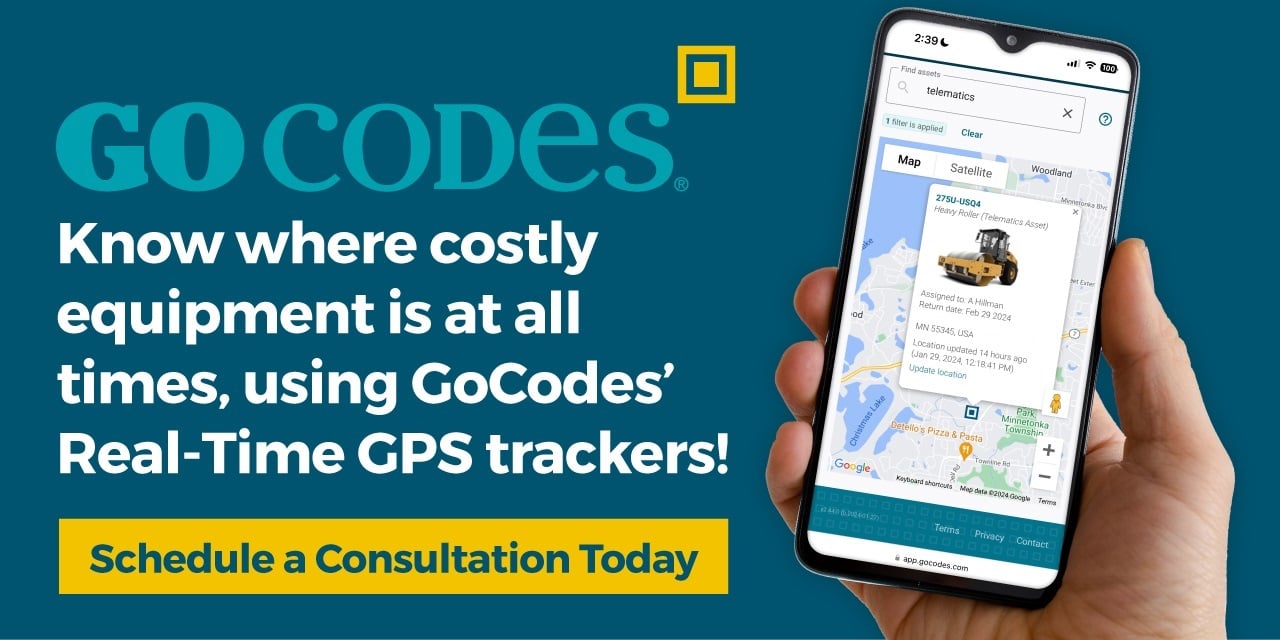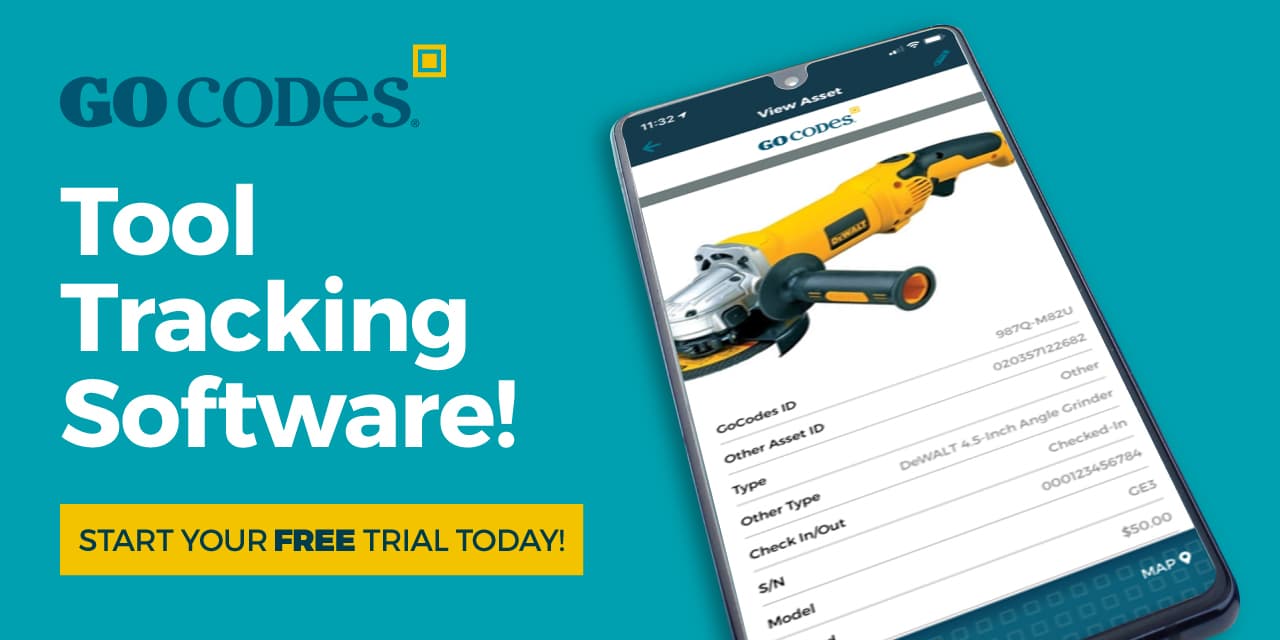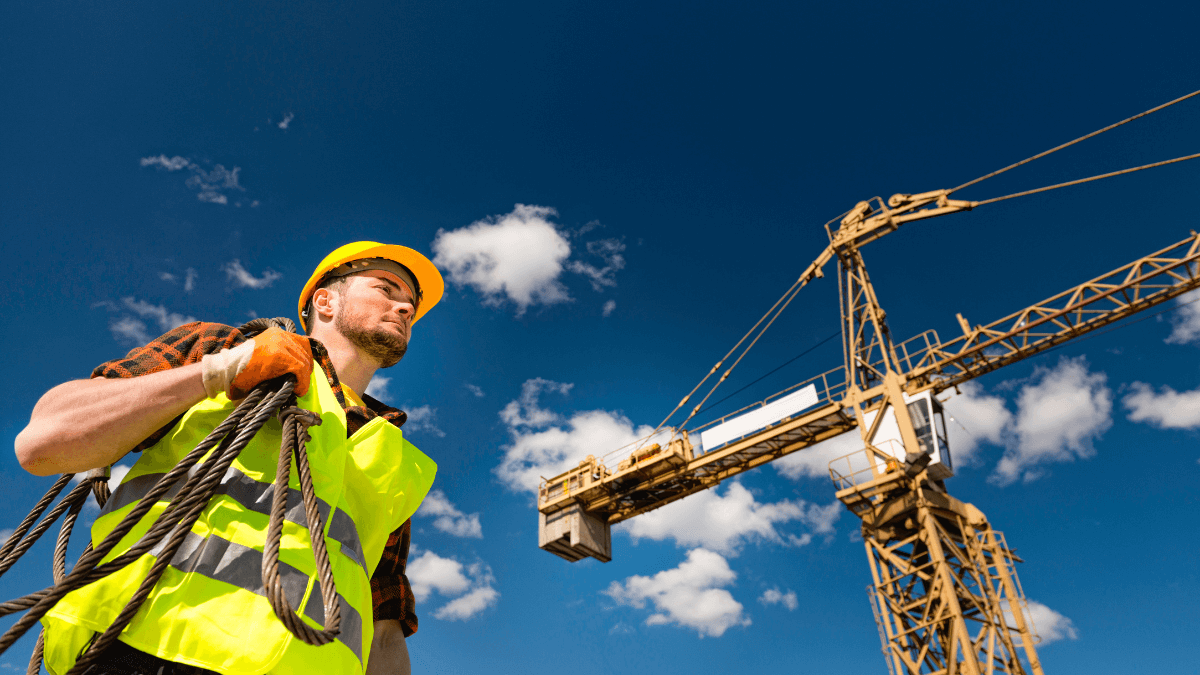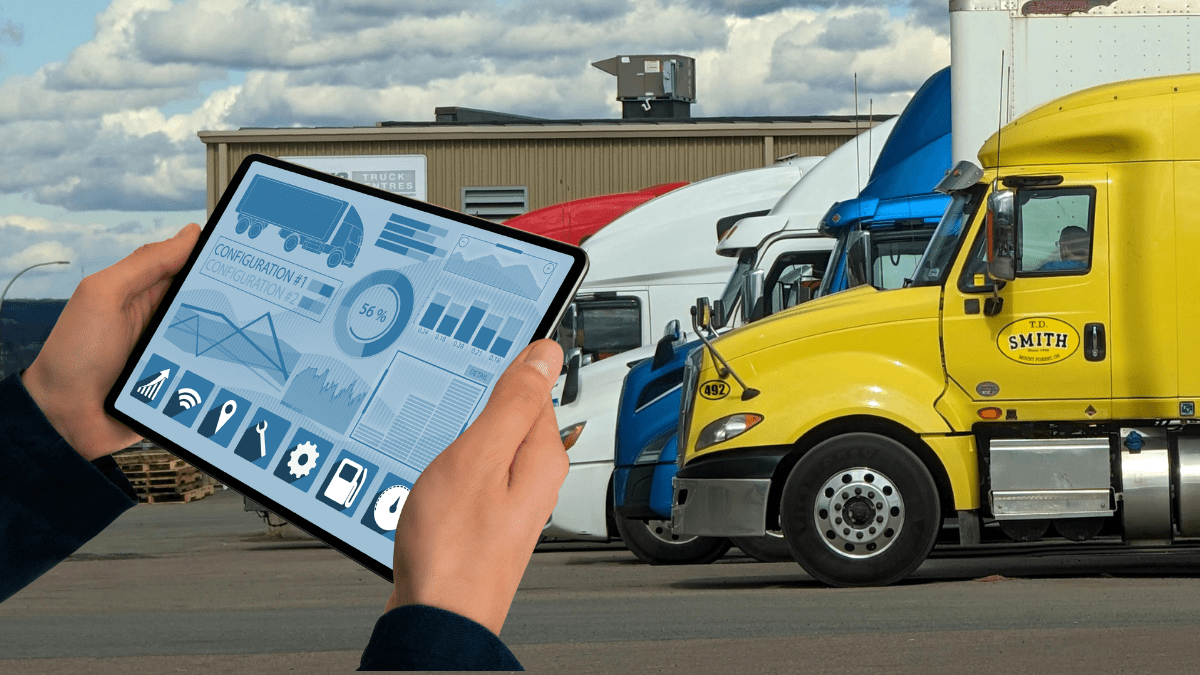Key Takeaways:
- Bluetooth tracking reduces the need for manual barcode or QR code scanning.
- BLE beacons and tags enhance on-site safety through access control and wearables.
- Using a single vendor or verified devices helps you avoid interoperability issues.
- Consider pairing BLE with GPS for off-site and long-range asset tracking.
Bluetooth tracking systems have become indispensable across multiple industries, helping businesses locate equipment, monitor inventory, and access valuable data.
Thanks to advances in Bluetooth Low Energy (BLE) technology, these systems now offer a practical, cost-effective solution for construction companies.
Looking to track your assets, monitor staff, and boost site visibility?
This guide covers everything you need to know about Bluetooth tracking and how it can enhance your construction operations.
In this article...
Understanding Bluetooth Tracking Technology
Bluetooth tracking relies on short-range radio signals to enable two-way communication between a tracking device and an object, allowing seamless location tracking and navigation.
At the heart of most modern Bluetooth tracking systems is Bluetooth Low Energy (BLE) technology.
While standard Bluetooth was built for continuous data transmission like wireless audio streaming, BLE favors power efficiency, sending smaller quantities of data at regular intervals.
It’s also important to note that all Bluetooth technology is proximity-based.
So, unlike GPS trackers, which use satellites to calculate real-time positions anywhere in the world, BLE devices simply broadcast signals within a limited range—without a continuous connection.
Toms Madžulis, Export Sales Manager at Mapon, explains that this is the defining feature of BLE tracking that helps you keep power consumption as low as possible.
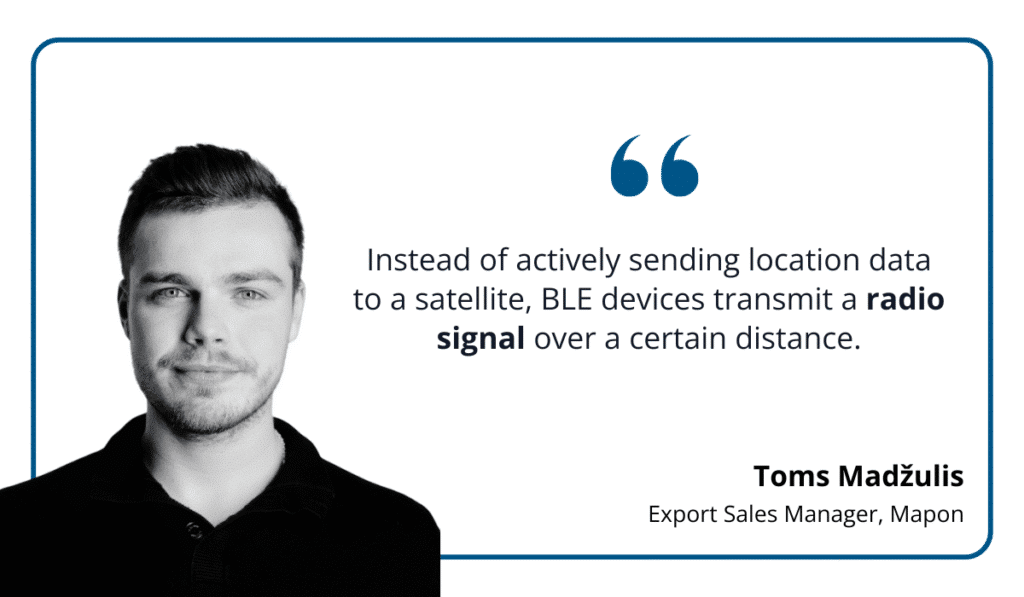
Illustration: GoCodes Asset Tracking / Quote: Mapon on YouTube
In addition to conserving battery life, BLE devices also eliminate the need for manually scanning equipment and inventory, which simplifies asset tracking.
As shown in the video below, BLE-enabled asset tracking ensures that equipment can be located in real time without interrupting workflows.
Source: Mapon on YouTube
BLE tracking systems have proven invaluable across a wide range of industries, from construction and manufacturing to healthcare.
However, making the most of this technology means understanding and distinguishing between:
- Bluetooth beacons
- Bluetooth tags
BLE beacons are larger devices installed at key locations across a site, thereby continuously broadcasting signals within a predefined range.
They are typically more rugged than tags, as well as tamper-resistant.
Meanwhile, BLE tags are built for mobility. While they can be quite durable, tags are typically smaller and lightweight so that they can be attached to assets, equipment, or worn by staff.
The easiest way to differentiate between the two is by focusing on their use cases.

Source: GoCodes Asset Tracking
Although your tracking system doesn’t require both types of devices to function, BLE beacons are necessary for positioning and enhanced location accuracy across the site.
Companies can also pair BLE trackers with other location tracking technologies to create a hybrid system that overcomes the limitations of individual solutions.
As mentioned, GPS offers global coverage essential for tracking vehicles and large, powered equipment over long distances.
However, its higher energy consumption and poor indoor performance limit its use in closed environments.
In contrast, BLE provides better precision in short-range, indoor, and semi-enclosed environments.
Here’s how they compare at a glance:
| Bluetooth | GPS | |
|---|---|---|
| Price | $ | $$-$$$ (hardware + subscription) |
| Range | Up to 300 ft (approx. 100 m) | Global |
| Energy Consumption | Low | High, real-time tracking |
| Geofencing | Reliant on proximity to beacon/gateway | Can set up multiple geofenced areas globally |
| Size | Wide variety of assets, e.g., tools and helmets | Best for larger or powered equipment due to size and power needs |
| Rechargeable Battery | Available | Available |
Now, let’s compare BLE to RFID, which operates a bit differently.
As Vishal Singh, RFID Solutions Sales Manager at Stallion Group, notes, RFID can provide pinpoint accuracy in controlled environments, outperforming Bluetooth in terms of precision.

Illustration: GoCodes Asset Tracking / Quote: LinkedIn
However, RFID’s shorter range and higher implementation costs limit its use on large, open construction sites.
In contrast, Bluetooth tracking stands out for its ability to deliver reliable, cost-effective, and energy-efficient location data across dynamic environments.
Ultimately, the goal is to improve site visibility, safety, and asset control, so let’s explore how Bluetooth tracking can make that a reality.
Advantages of Bluetooth Tracking on Construction Sites
Let’s dive into the specific benefits of introducing Bluetooth tracking on construction sites.
Reduces Equipment Loss
One of the primary benefits of Bluetooth tracking is its ability to reduce equipment loss, which is a persistent and costly issue in construction.
By attaching BLE tags to valuable tools, machinery, and materials, companies can prevent theft, unauthorized movement, and accidental misplacement.
These tags communicate with Bluetooth beacons or gateways positioned around the site, which makes it possible to:
- Locate obscured or misplaced items quickly and easily
- Receive instant alerts if equipment leaves a designated area
As David Mattan, Managing Director of Digipal, points out, inventory loss is one of the first pain points that comes up when speaking with potential clients.

Illustration: GoCodes Asset Tracking / Quote: Mr. Beacon on YouTube
The reason why is clear: missing tools or materials disrupt workflows, delay projects, and result in additional costs, due to both replacements and downtime.
The very nature of the problem provides an additional incentive to adopt tracking systems.
While some losses are the result of simple human error, construction sites worldwide face an increasing danger of theft.
The UK’s ongoing tool theft epidemic continues to make headlines, and while much of the discussion centers on its impact on tradesmen, the issue is much more complex.
According to NFU Mutual research, over half of all thefts occur directly on construction sites, which you might expect to be more secure.

Illustration: GoCodes Asset Tracking / Data: NFU Mutual
Even more concerning, just 59% of theft victims had recorded their equipment’s serial numbers—the rest had cleared the path for inside jobs that make up 27% of on-site thefts.
So, how exactly can Bluetooth tracking help address this problem?
It comes down to increased site visibility and control.
Investing in maintaining an auditable, real-time record of equipment location and movements reduces equipment loss while boosting operational efficiency
Take the example of Eiffage Rail, a rail infrastructure provider.
They partnered with Charlier Solutions and ELA Innovation to roll out a Bluetooth tracking system across over 100 construction and maintenance sites.
With multiple subcontractors operating on the same sites, misplaced or borrowed tools were a constant issue.
As Edris Pougetoux of Eiffage Rail explains, with the system in place, one glance at the dashboard tells him everything he needs to know about their equipment.

Illustration: GoCodes Asset Tracking / Quote: ELA Innovation
With simplified asset search and access to detailed digital logs and equipment documentation, Eiffage Rail improved operational efficiency and regulatory compliance.
Moreover, the ability to track high-value equipment and small tools alike streamlined field-office communication while ensuring increased accountability.
In a fast-paced, high-risk industry like construction, equipment losses are common and costly, and Bluetooth tracking brings much-needed order and oversight.
Increases Safety
Bluetooth tracking systems increase the safety of everyone working on-site.
Simply put, the ability to monitor both asset and worker movements prevents accidents, which are all too common in construction.
While the industry is inherently dangerous, which contributes to a high number of fatalities every year, it’s worth zooming in on specific numbers.
Namely, after analyzing the data from the U.S. Bureau of Labor Statistics, the National Safety Council (NSC) determined that over 4,500 construction deaths were entirely preventable.

Illustration: GoCodes Asset Tracking / Data: National Safety Council
Although this is still a high number, the comparison with the previous year showed that the total number of deaths decreased by 3%.
This is in no small part due to a better safety culture in construction, as well as access to advanced technologies available on the market.
For one, asset tags and various sensors give you greater insight into asset usage and the overall condition of each piece, minimizing the chances of potentially dangerous breakdowns.
More directly, BLE tags worn by workers enable you to track their location across hazardous zones or restricted areas and issue timely warnings thanks to real-time access notifications.
Wearables also support overall compliance efforts, but the most important thing is direct crew protection.
Just take a look at the Bluetooth helmet tag designed by the IoT manufacturing vendor Minew.
Source: Minew Tech on YouTube
While BLE tags can be worn around the neck, they can also be a nuisance for workers as they complete different tasks in the field.
This is why Minew focused on producing a more comfortable solution—the easy-to-install tag has a curved design for a more ergonomic fit and better durability, and is never in the way.
If you’re not exactly sure about the effectiveness of these solutions, let’s take a closer look at one study focused on the reliability of IoT-based tracking systems.
The tested system had Bluetooth modules integrated into hard hats, achieving highly accurate real-time intrusion detection on construction sites.
The system recorded detection errors as low as 0.012 and locating errors under 0.1 meters, with alarm notifications sent in under one second, as presented in the table below.
| Tracking Systems | Detection Error | Locating Error | Alarming Delay |
|---|---|---|---|
| IoT-based system (w/ Bluetooth modules) | 0.012 | < 0.1 | < 1 |
| CSS-based system | 0.023 | < 1 | < 1 |
| GPS-based system | – | < 2.5 | – |
| RFID-based system | – | < 0.1 | – |
| UWB-based system | – | < 0.3 | – |
Bluetooth’s performance stood out even more when compared to other tested systems.
Whether it’s managing access to restricted areas, keeping tabs on valuable assets, or tracking workers in real time, Bluetooth-enabled systems strengthen site safety by delivering fast, reliable, and precise location data.
Low Power Consumption
One of the most valuable features of Bluetooth Low Energy (BLE) technology shows up right in its name, and that’s minimal power requirements.
Since BLE transmits short-range data relatively infrequently, it consumes far less energy than traditional systems, conserving battery life.
As IoT expert Aditya Thakekar explains, the low power draw is one of BLE’s defining advantages.

Illustration: GoCodes Asset Tracking / Quote: LinkedIn
The reason is that it saves your company’s money at every step, from reducing battery replacement costs to the labor needed for frequent servicing.
These advantages greatly contribute to the BLE market’s projected growth, from 9.54 billion in 2023 to 12.65 billion by 2033.

Illustration: GoCodes Asset Tracking / Data: Evolve BI
BLE beacons and tags can operate for months, and in some cases even years, on a single coin-cell battery.
Of course, there are various factors, such as:
- Signal strength
- Transmission frequency
- Beacon model
To put it into perspective, a beacon transmitting a signal within a 10-meter range every five seconds could outlast a beacon that’s sending signals every three seconds over a 30-meter radius.
And it would do so by a significant margin.
This flexibility allows businesses to tailor power consumption based on the asset’s value, risk level, or location, and prioritize critical areas without overburdening resources.
Beyond battery lifespan, low energy consumption also lowers the total cost of ownership for tracking systems.
Construction sites are typically large, dynamic, and exposed to harsh weather conditions, making it impractical to frequently recharge or replace device batteries.
BLE’s efficient operation solves this challenge while providing reliable, real-time asset visibility.
Additionally, modern BLE systems often include dashboards that monitor beacon activity and power levels in real time, enabling proactive management.
The detected power consumption in an idle state is recorded below.

Source: NovelBits
Naturally, optimizing power consumption can feel like a major challenge, unless you’ve incorporated these four strategies into your management.
These include adjusting transmission intervals, optimizing beacon placement, and using built-in sleep modes that can further extend battery life and maximize system uptime.

Source: GoCodes Asset Tracking
In demanding, fast-paced construction environments, BLE’s power efficiency directly translates to fewer interruptions, lower operational costs, and increased site visibility.
This is why it’s high time to explore practical and scalable solutions for modern asset tracking needs, wouldn’t you say?
Setting Up a Bluetooth Tracking System
Implementing a Bluetooth tracking system on a construction site is straightforward if approached in clear, manageable steps.
While this is a simplified guide, the essentials remain the same, from choosing compatible devices and positioning beacons to connecting everything with software.

Source: GoCodes Asset Tracking
The process typically begins with selecting compatible devices — BLE beacons and receivers that integrate smoothly with your asset management software.
That’s exactly what guided the design of GoCodes Asset Tracking’ BLE beacon trackers: these durable, construction-ready devices have a 4-year battery life and built-in features like instant email alerts when an asset leaves its assigned area.

Source: GoCodes Asset Tracking
Once your hardware is in hand, the next step is strategic beacon placement.
It’s vital to focus on areas with strong signal coverage and minimal interference, usually elevated or open spots with a clear line of sight.
Keep in mind that construction sites are busy, signal-heavy environments, which is why it’s likely you’ll need to install more Bluetooth receivers than you originally planned, affecting the costs.
After this setup, it’s time to connect your beacons to an asset management platform.
The software should display real-time asset locations, status updates, and battery levels from a single, easy-to-navigate dashboard.
GoCodes Asset Tracking’ system delivers precisely that—a centralized, mobile-accessible platform that streamlines monitoring, setting up alerts, and responding quickly to misplaced or relocated tools.

Source: GoCodes Asset Tracking
One of the biggest pitfalls in the BLE system setup is overlooking the technical side of things.
As highlighted in a study on Bluetooth’s evolution, technical issues like interference, scalability, and interoperability are common.
Interoperability is especially tricky given that devices from different manufacturers rarely communicate smoothly, as noted by the study’s authors:

Illustration: GoCodes Asset Tracking / Quote: MDPI
The safest solution?
Sticking to a single vendor’s BLE ecosystem or using verified devices that you know are compatible with each other.
Lastly, while BLE is reliable for short-range tracking, it’s worth considering hybrid solutions.
These can include real-time GPS trackers for high-value, movable equipment and GPS-enabled QR code tags for smaller assets and tools.
Conclusion
So, what’s your take on Bluetooth Low Energy (BLE) technology?
If you’ve made it this far, chances are you’ve arrived at the same conclusion we have: BLE is a smart, low-maintenance, short-range location tracking solution that can transform even the most demanding worksites.
With its long battery life, real-time tracking, and energy efficiency, it helps cut equipment losses, boost site security, and improve oversight.
Invest in a reliable BLE ecosystem, and consider adding GPS for broader coverage, and you’ll future-proof your asset tracking strategy in no time!



